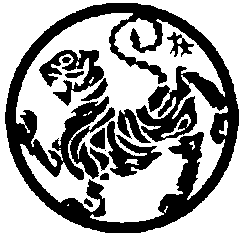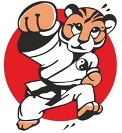Shotokan karate

Karate Shotokan is one of the four main styles of karate in Japan. Shotokan is a style of karate, developed from various martial arts by Gichin Funakoshi (1868–1957) and his son Gigo Yoshitaka. Shoto, meaning "pine-waves" was Funakoshi's pen-name, which he used in his poetic and philosophical writings and messages to his students. The Japanese kan means "house" or "hall". The emblem of style is the tiger.
Style features
Techniques in kihon and kata are characterised by deep, long stances that provide stability, enable powerful movements, and strengthen the legs. Shotokan is regarded as a dynamic martial art as it develops anaerobic, powerful techniques as well as developing speed. Initially strength and power are demonstrated instead of slower, more flowing motions. Ikken Hissatsu is a fundamental term used in Shotokan karate, meaning "to annihilate at one blow". The program of Shotokan Karate-do consists of 26 different kata - they are called classic - the study and implementation of which is the most important component of the training.
Shotokan is the most dynamic, entertaining and the most popular Japanese style of karate. According to the KW, about 80% of all karatekas are engaged in the style of Shotokan.
Style Shotokan is practiced by:
International federations of A category
- World Karate Federation (WKF)
- Shotokan Karate-Do International Federation (S.K.I.F)
- Japan Karate Association (JKA)
- International Traditional Karate Federation (ITKF)
- World Karate Confederation (WKC)
International federations of B category
- World Union of Karate-do Federations (WUKF)
- World Union of Karate-do Organizations (WUKO)
- Japan Shotokan Karate Association (JSKA)
- World Shotokan Karate-do Federation (W.S.K.F)
- World Shotokan Karate-do Association (WSKA)


